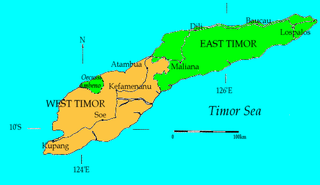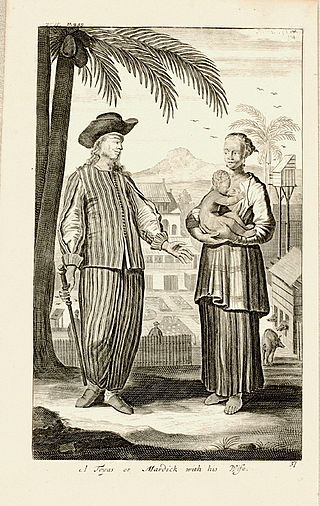Related Research Articles

West Timor is an area covering the western part of the island of Timor, except for the district of Oecussi-Ambeno. Administratively, West Timor is part of East Nusa Tenggara Province, Indonesia. The capital as well as its main port is Kupang. During the colonial period, the area was named Dutch Timor and was a centre of Dutch loyalists during the Indonesian National Revolution (1945–1949). From 1949 to 1975 it was named Indonesian Timor.

Portuguese Timor was a colonial possession of Portugal that existed between 1702 and 1975. During most of this period, Portugal shared the island of Timor with the Dutch East Indies.

Kupang, formerly known as Koepang or Coupang, is the capital of the Indonesian province of East Nusa Tenggara. At the 2020 Census, it had a population of 442,758; the official estimate as of mid-2023 was 466,632. It is the largest city and port on the island of Timor, and is a part of the Timor Leste–Indonesia–Australia Growth Triangle free trade zone. Geographically, Kupang is the southernmost city in Indonesia.

Amabi was a traditional principality in West Timor in the currently East Nusa Tenggara province of Indonesia. From at least the 17th century to 1917, Amabi played a role in the rivalries between the Portuguese and Dutch colonials on Timor Island.
Sonbai was an Indonesian princely dynasty that reigned over various parts of West Timor from at least the 17th century until the 1950s. It was known as the most prestigious princedom of the Atoni people of West Timor, and is the subject of many myths and stories.

Topasses were a group of people led by the two powerful families – Da Costa and Hornay – that resided in Oecussi and Flores. The Da Costa families were descendants of Portuguese Jewish merchants and Hornay were Dutch.
Gaspar da Costa was the leader or tenente geral of the Portuguese-speaking Topasses, a Eurasian group that dominated much of the politics on Timor in the early modern period. He was largely responsible for the dramatic collapse of Portuguese power in West Timor, a process that laid the foundations for the modern division of Timor in an Indonesian and an independent part.

Wehali is the name of a traditional kingdom at the southern coast of Central Timor, now in Indonesia and East Timor. It is often mentioned together with its neighbouring sister kingdom, as Wewiku-Wehali (Waiwiku-Wehale). Wehali held a position of ritual seniority among the many small Timorese kingdoms.

Amanuban was a traditional princedom in West Timor, Indonesia. It lay in the regency (kabupaten) Timor Tengah Selatan. In the late colonial period, according to an estimate in 1930, Amanuban covered 2,075 square kilometers. The centre of the princedom since the 19th century was Niki-Niki. The population belongs to the Atoni group. Today they are predominantly Protestants, with a significant Catholic minority and some Muslims.

Amanatun was an Atoni princedom situated in what is today Indonesian West Timor, which existed up to 1962. It was also known as the princedom of Onam. The area once included one of the best ports where the commercially important sandalwood was loaded on Dutch and Portuguese ships.
Sonbai Besar or Greater Sonbai was an extensive princedom of West Timor, in present-day Indonesia, which existed from 1658 to 1906 and played an important role in the history of Timor.
Sonbai Kecil or Lesser Sonbai was an Atoni princedom in West Timor, now included in Indonesia. It existed from 1658 to 1917, when it merged into a colonial creation, the zelfbesturend landschap Kupang.
Amarasi was a traditional princedom in West Timor, in present-day Indonesia. It had an important role in the political history of Timor during the 17th and 18th century, being a client state of the Portuguese colonialists, and later subjected to the Netherlands East Indies.

Indo people are a Eurasian people of mixed Asian and European descent. Through the 16th-18th centuries, they were known by the name Mestiço. To this day, they form one of the largest Eurasian communities in the world. The early beginning of this community started with the arrival of Portuguese traders in South East Asia in the 16th century. The second large wave started with the arrival of the Dutch East India Company (VOC) employees in the 17th century and throughout the 18th century. Even though the VOC is often considered a state within a state, formal colonisation by the Dutch only commenced in the 19th century.

Oecusse, also known as Oecusse-Ambeno and formerly just Ambeno, officially the Special Administrative Region Oecusse-Ambeno, is an exclave, municipality and the only Special Administrative Region (SAR) of East Timor.
Portuguese Indonesians are native Indonesians with Portuguese ancestry or have had adopted Portuguese customs and some practices such as religion.

The Kingdom of Larantuka was a historical monarchy in present-day East Nusa Tenggara, Indonesia. It was one of the few, if not the only, indigenous Catholic polities in the territory of modern Indonesia. Acting as a tributary state of the Portuguese Crown, the Raja (King) of Larantuka controlled holdings on the islands of Flores, Solor, Adonara and Lembata. It was later purchased by Dutch East Indies from the Portuguese, prior to its annexation in 1904.
East Timorese nationality law is regulated by the 2002 Constitution, the Nationality Act of the same year, the regulation of the Nationality Act Decree-Law No. 1 of 2004, as well as various international agreements to which East Timor has been a signatory. These laws determine who is, or is eligible to be, a national of East Timor. The legal means to acquire nationality and formal membership in a nation differ from the relationship of rights and obligations between a national and the nation, known as citizenship. East Timorese nationality is typically obtained either on the principle of jus soli, i.e. by birth in East Timor; or under the rules of jus sanguinis, i.e. by birth abroad to at least one parent with East Timorese nationality. It can also be granted to a permanent resident who has lived in East Timor for a given period of time through naturalization.

Fort Santo António de Lifau was a Portuguese fort once built by the mouth of the Tono River, in Lifau, district of Oecusse, in East-Timor, the first fort built by the Portuguese Crown, where only forts maintained by Dominican missionaries and Portuguese merchants previously existed.

Fort Maubara is a small Dutch colonial fortress located in the East Timorese town of Maubara, Suco Vaviquinia, Maubara administrative post, Liquiçá municipality. The rectangular fort, on whose wall two cannons still stand, is the most striking building in the town. It is located directly at the entrance to Maubara, on the well-developed thoroughfare, from where visitors could see the entire bay from the beach. The fort is owned by the state, but is managed by the Maubara Association Mós Bele.
References
Footnotes
- 1 2 3 4 Hägerdal 2012, p. 364.
- 1 2 3 4 5 Andaya 2010, p. 413.
- 1 2 3 Andaya 2010, p. 415.
- ↑ Andaya 2010, pp. 395–397.
- 1 2 3 Durand, Frédéric (7 January 2016). "Three centuries of violence and struggle in East Timor (1726–2008)". Online Encyclopedia of Mass Violence. Retrieved 8 February 2019.
- 1 2 Parimartha, I Gede (2008). "Contextualizing trade in East Nusa Tenggara, 1600–1800". Linking Destinies: Trade, Towns and Kin in Asian History. BRILL. pp. 71–73. ISBN 9789004253995.
- ↑ Andaya 2010, pp. 409–411.
- 1 2 Kratoska 2001, p. 204.
- ↑ Hägerdal 2012, pp. 111, 123.
- ↑ Kratoska 2001, p. 205.
- ↑ Nordholt 2014, p. 172.
- 1 2 Nordholt 2014, p. 180.
- 1 2 Hägerdal 2008.
- ↑ Sejarah daerah Nusa Tenggara Timur (in Indonesian). Departemen Pendidikan dan Kebudayaan, Proyek Inventarisasi dan Dokumentasi Kebudayaan Daerah. 1984. p. 45.
- ↑ Andaya 2010, p. 414.
- ↑ Nordholt 2014, p. 178.
- 1 2 3 4 Hägerdal 2012, pp. 366–367.
- 1 2 3 Andaya 2010, pp. 415–416.
- 1 2 3 Hägerdal 2012, pp. 367–369.
- 1 2 3 Nordholt 2014, p. 181.
- ↑ Cribb, Robert (2013). Historical Atlas of Indonesia. Routledge. p. 99. ISBN 9781136780585.
- ↑ Andaya 2010, p. 416.
- ↑ End, Hakh & Soleiman 2005, pp. 3, 20.
- ↑ Andaya 2010, p. 417.
- ↑ Hägerdal 2012, p. 371.
- ↑ Andaya 2010, pp. 418–419.
- ↑ End, Hakh & Soleiman 2005, p. 19.
Bibliography
- Andaya, Leonard Y. (2010). "The 'informal Portuguese empire' and the Topasses in the Solor archipelago and Timor in the seventeenth and eighteenth centuries". Journal of Southeast Asian Studies. 41 (3): 391–420. doi:10.1017/S002246341000024X. JSTOR 20778895. S2CID 154873647.
- End, Th van den; Hakh, Samuel B.; Soleiman, Yusak (2005). Sejarah Gereja Protestan di Indonesia: 27 Februari 1605 – 27 Pebruari 2005 (in Indonesian). Badan Pekerja Harian, Gereja Protestan di Indonesia. ISBN 9789799932112.
- Hägerdal, Hans (2008). "White and Dark Stranger Kings: Kupang in the Early Colonial Era". Moussons. Recherche en Sciences Humaines Sur l'Asie du Sud-Est (12): 137–161. doi: 10.4000/moussons.1510 . ISSN 1620-3224.
- Hägerdal, Hans (2012). Lords of the Land, Lords of the Sea: Conflict and Adaptation in Early Colonial Timor, 1600–1800. BRILL. doi:10.1163/9789004253506. ISBN 9789004253506.
- Kratoska, Paul H. (2001). South East Asia, Colonial History: Independence through revolutionary war. Taylor & Francis. ISBN 9780415247856.
- Nordholt, H. G. Schulte (2014). The Political System of the Atoni of Timor. BRILL. ISBN 9789004286900.